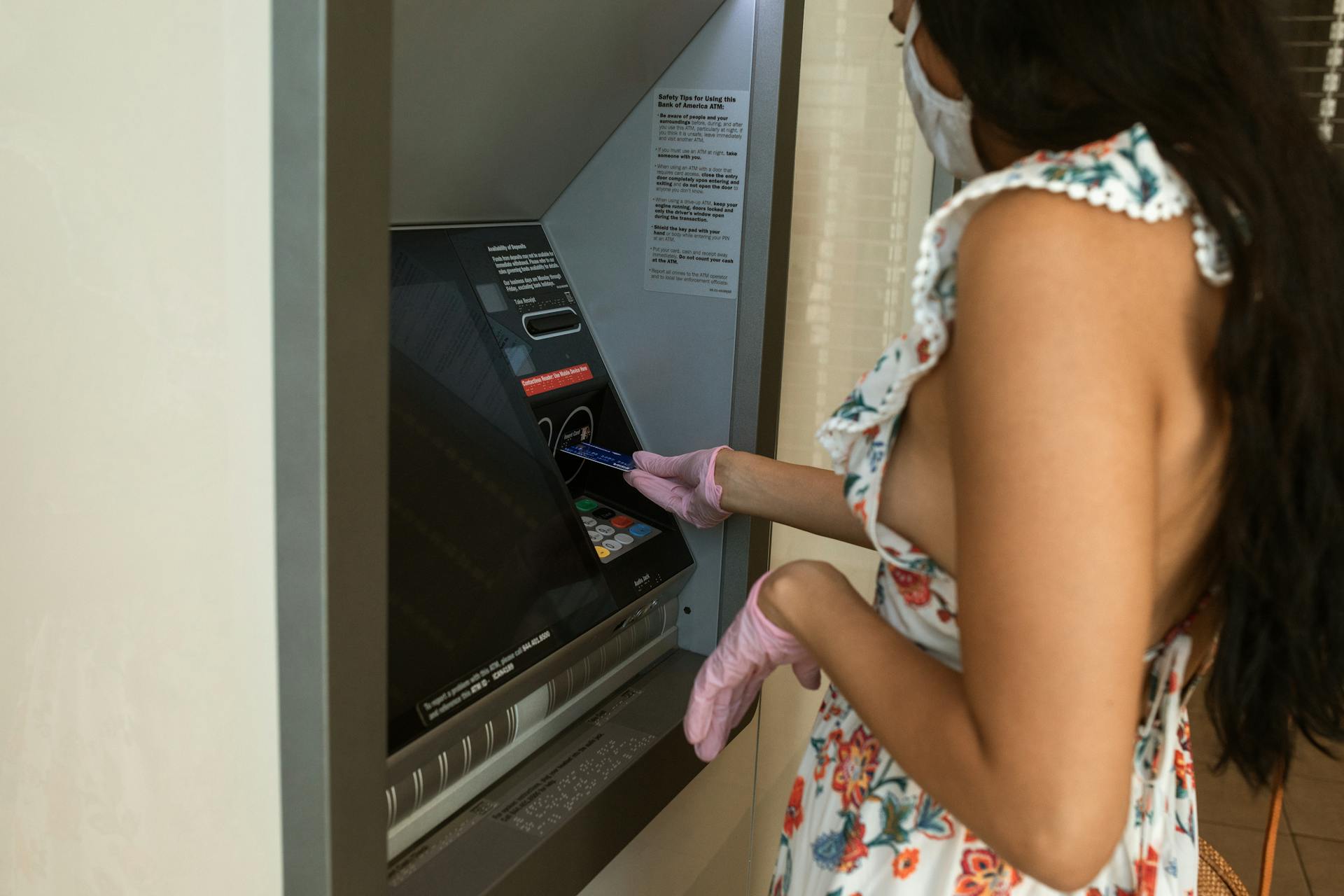
The cash reserve ratio formula is a crucial concept in banking that helps determine the minimum amount of funds a bank must hold in reserve. This reserve is a percentage of the bank's deposits that must be kept in a liquid, easily accessible form.
To calculate the cash reserve ratio, you'll need to know the formula, which is: Cash Reserve Ratio = (Required Reserve / Total Deposits) x 100. This formula is used to determine the percentage of deposits that must be held in reserve.
A cash reserve ratio of 10% means that for every $100 in deposits, the bank must hold $10 in reserve. This ensures that banks have enough liquidity to meet customer withdrawals and other financial obligations.
You might enjoy: How Much Money Is in an Atm
What Is the Cash Reserve Ratio?
The cash reserve ratio is a key concept in banking and finance. It's a percentage of deposits that commercial banks are required to hold in reserve and not lend out.
This reserve is typically held in the form of cash or liquid assets that can be easily converted to cash. The cash reserve ratio is usually set by a country's central bank.
In simple terms, if a bank has a cash reserve ratio of 10%, it means that for every 100 units of deposits, it must keep 10 units as reserves and not lend out the other 90 units. This ratio helps to maintain financial stability.
The cash reserve ratio is often used as a tool to control inflation, prevent bank runs, and maintain economic stability. It's also used to regulate the money supply in an economy.
By keeping a portion of deposits as reserves, banks can prevent themselves from lending too much money and creating too many new deposits, which can lead to inflation.
For your interest: List of Banks in Nigeria
Calculating Requirements
Calculating the reserve requirement is a straightforward process. You need to take the reserve ratio percentage and convert it to a decimal. This is done by simply dividing the percentage by 100.
Suggestion: What Is Apy in Banking Terms
For example, if the reserve ratio is 11%, you would divide 11 by 100 to get 0.11. Multiply this decimal by the amount of deposits a bank holds, and you'll get the reserve requirement. In the case of a bank with $1 billion in deposits, the reserve requirement would be $110 million.
The reserve ratio formula is also useful for calculating the required reserve ratio. This is done by dividing the reserves held by the bank by the total deposits, and then multiplying by 100 to convert it to a percentage. For instance, if a bank holds $100 million in reserves and has $1,000 million in total deposits, the required reserve ratio would be 10%.
The reserve ratio is determined by a country's central bank, and in the United States, it's set by the Federal Reserve. The required reserve ratio is used in monetary policy planning to regulate the amount of cash banks can convert to loans and protect banks from a sudden decline in liquidity.
Here's a simple formula to calculate the reserve requirement:
Reserve Requirement = (Reserve Ratio / 100) x Total Deposits
Check this out: Combank Level 1
Money Supply and Multiplier
The money supply is a fundamental concept in economics, and it's closely tied to the reserve ratio and the money multiplier. In a fractional reserve banking system, the money supply can increase significantly due to lending and borrowing.
The reserve ratio is a key factor in determining how much credit money banks can make by lending out deposits. For example, if a bank has $500 million in deposits, it must hold $50 million, or 10%, in reserve.
This reserve requirement defines the so-called money multiplier, which can be as high as 1,000 in some cases. The money multiplier is the ratio of the increase in the money supply to the initial deposit.
In a fractional reserve banking system, the money supply can increase by a multiple of the initial deposit. The equation to approximate this relationship is: Change in the money supply = Increase in loanable deposit / Reserve Ratio.
Related reading: In a Fractional Reserve Banking System Banks Create Money Because
The reserve ratio determines how much of the initial deposit is held in reserve, and how much can be lent out to create new deposits. If the reserve ratio is low, the money multiplier can be high, and the money supply can increase significantly.
A low reserve ratio can lead to a high money multiplier, which can result in a rapid increase in the money supply. However, this also means that the banking system is more vulnerable to economic shocks.
Related reading: Bank of America Credit Card Credit Limit Increase
Guidelines and Requirements
The Federal Reserve has the sole authority to change reserve requirements within limits specified by law. As of March 26, 2020, the reserve requirement was set at 0%, allowing banks to use funds to lend to customers instead of keeping them at their Reserve Bank.
Banks with more than $124.2 million in net transaction accounts were required to maintain a reserve of 10% of net transaction accounts as of January 2019. Banks with more than $16.3 million to $124.2 million needed to reserve 3% of net transaction accounts.
To calculate a reserve requirement, you convert the reserve ratio percentage to a decimal and multiply it by the amount of deposits a bank holds. For example, if the reserve ratio was 11%, and a bank had a deposit of $1 billion, the reserve requirement would be $110 million.
Worth a look: Fdic Insurance for Business Accounts
What Is Required?

The reserve requirement is a crucial aspect of banking regulations. It's the percentage of total deposits that banks must keep in reserve.
Banks with more than $124.2 million in net transaction accounts were required to maintain a reserve of 10% of net transaction accounts. This was the case before the pandemic.
To calculate the reserve requirement, you need to convert the reserve ratio percentage to a decimal and then multiply it by the amount of deposits a bank holds. For example, if the reserve ratio was 11%, a bank with a deposit of $1 billion would have a reserve requirement of $110 million.
The reserve ratio formula is simple: Required reserve ratio = Reserves / Total deposits. In one example, this formula yielded a required reserve ratio of 10%.
In the United States, the majority of banks fell into the category where they were required to maintain a reserve of 10% of net transaction accounts. This was the case before the pandemic.
Banks can lend out a portion of their deposits, but they must keep a certain percentage in reserve. For example, if the required reserve ratio is 10, a bank can lend out $0.90 of each dollar.
You might like: What Is Transaction Banking
Zero Requirement

The zero requirement is a fascinating concept that can have a significant impact on the financial system. As of March 26, 2020, the Federal Reserve of the United States set the reserve requirement ratio to zero percent, eliminating reserve requirements for all depository institutions.
This action allowed banks to hold as little as possible in reserve, freeing up more funds for lending and other activities. The zero reserve requirement was a temporary measure aimed at providing relief to the economy during the COVID-19 pandemic.
The elimination of reserve requirements gave banks more flexibility to manage their liquidity and respond to changing market conditions.
On a similar theme: Zero Coupon Rate Formula
Calculating and Applying
Calculating the reserve ratio is a straightforward process that involves dividing the cash reserve maintained with the central bank by the bank deposits, and expressing it as a percentage. This formula is used to determine the portion of total deposits that commercial banks are obligated to maintain with the central bank.
Discover more: Argentina Central Bank News
To calculate the reserve requirement, you need to convert the reserve ratio percentage to a decimal and then multiply it by the amount of deposits a bank holds. For example, if the reserve ratio is 11% and a bank has a deposit of $1 billion, the reserve requirement would be $110 million.
The reserve ratio can be calculated using the formula: Reserve Ratio = Reserve maintained with Central Bank / Bank Deposits * 100%. Alternatively, you can use a calculator or follow a step-by-step process to determine the reserve ratio.
To apply the reserve ratio, you need to consider the total deposits, reserves, and loanable funds. The sum of reserves and loans must equal the total deposits. For instance, if a bank has a total deposit of $1,000 million and a required reserve ratio of 10%, it must keep at least $100 million as reserves.
Here's a simple formula to calculate the required reserve ratio: Required reserve ratio = Reserves / Total deposits. Using this formula, you can easily determine the required reserve ratio based on the total deposits and reserves.
To compute the reserve ratio, follow these steps: Determine the total deposits, check the total reserves, and divide the reserves by the total deposits to obtain the reserve ratio. This will give you a clear understanding of the reserve ratio and how it applies to your specific situation.
On a similar theme: Cash Flow on Total Assets Ratio Formula
Featured Images: pexels.com


